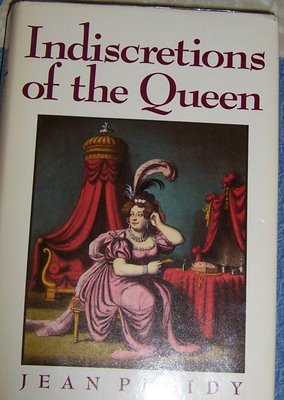Taking a break from medieval/Tudor times, I read—or, in the case of one book, started to read—two novels about two famous wives: Juliet Waldron’s
Mozart’s Wife and Diane Haeger’s
The Secret Wife of King George IV. (Isn’t it nice when the titles save the trouble of an explanation?)
The good news first: I found
Mozart’s Wife, published in 2004, to be absorbing and well-written. It follows Konstanze’s life as she grows from a naive young girl to a capable, shrewd woman, her marriage as it disintegrates under the pressures of too many bills, infant mortality, and infidelity.
Konstanze is the narrator here, and her voice is a refreshing one: informal, earthy without becoming coarse, candid, un-self-pitying, and wry. She and Mozart are highly flawed but likable people, who never forfeit our sympathies even as they act appallingly toward each other and toward others. That’s very difficult for an author to pull off, and Waldron does it admirably.
Waldron has a nice eye for detail. As a mistress of Mozart’s departs the cramped household, she is accompanied by her cats: “Her calico Mutzie and tiger Murr followed, tails up, for all the world like a couple of well-behaved dogs out for a walk.”
The book does feel a little disjointed in spots. For instance, Konstanze spends much of Chapter 20 fussing over an impending visit from Leopold, Mozart’s difficult father, but the visit is never depicted; when we next hear of Leopold two chapters later, the matter seems to have been forgotten. Did something get cut? I also felt that too little emphasis was placed on Mozart’s Masonic ties, considering the crucial role they later assumed in Waldron’s explanation of his death and obscure burial.
All in all, though, I enjoyed this book thoroughly. Waldron also has one of the nicer websites I've seen for a historical novelist; check it out
here.
I can’t say I derived the same enjoyment from
The Secret Wife of King George IV, Diane Haeger’s 2001 novel about Maria Fitzherbert. In fact, I didn’t finish it; the novel is 373 pages long, and I managed to read only to page 105.
What stopped me? For one thing, the action in these pages revolves around Maria, who as depicted by Haeger is simply not very interesting. We learn that she has “ivory shoulders,” “pale gold hair,” and eyes as “deep as melting chocolate,” and that this combination has the effect of making men fall instantly in love with her, but we learn almost nothing about what lies behind Maria’s beautiful exterior. We’re told that she wants to marry for love, having been married twice for advantage, and that her Catholic beliefs keep her from agreeing to become George’s mistress, but other than that, it’s 105 pages of ivory shoulders, gold hair, deep brown eyes, and lots of costume changes. This is fine if one’s flipping through
Vogue magazine, but when one’s reading a historical novel, it’s tedious.
To make matters worse, this part of the novel is taken up with Maria and George’s budding romance, and though we’re told that all sorts of sparks are flying between the couple, they never ignite for the reader. The couple meet, George makes an advance, Maria refuses it. Gossip ensues. The couple meet again. George makes another advance. Maria refuses it. More gossip ensues. And so forth. The dialogue between the couple is of the “unhand me, sir” variety: “'I cannot hear this! Please, Your Highness, do not continue!'” The prose sometimes approaches the ludicrous: “He was dangerous, wild, and totally forbidden. He was also masculine and wholly male.”
No girlie men here.
Frustratingly, there are signs that Haeger could have done a lot better. In a couple of scenes where George was talking to his father or to his old nurse or to a female friend, he became a genuinely interesting character, generous yet riddled with insecurities and anger, about whom I wanted to know more. Unfortunately, in a matter of pages, he was back to yammering, “'I want you. . . . I want all of you,'” to Maria. Perhaps things might have improved once he and Maria married (at least, surely, in the dialogue department), but with a pile of other books screaming for my attention, it just didn’t seem worth the effort to find out.
The Secret Wife of George IV did encourage me, at least, to have the library send over Jean Plaidy’s take on the same marriage:
The Sweet Lass of Richmond Hill. With that and Margaret George’s
Helen of Troy on the way, I should be able to keep myself out of trouble for a while.




